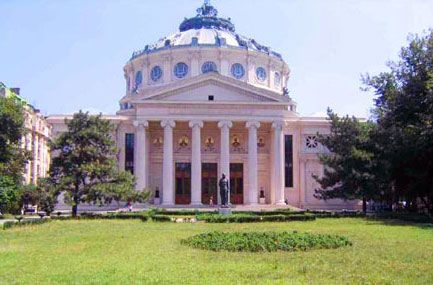
Atheneum, a concert hall in Bucharest, is located on Victory Way in George Enescu Square. Built in neoclassical style, with many decorative elements in typical French architecture over a century, the center building presents a rather an eclectic style.
The interior is, perhaps, even more impressive than the outside. In the entrance hall, there are four spirals staircase around the columns of marble from Carrara and decorative sculptures.
The hall show, with a great acoustics, has 600 seats downstairs and 52 seats at Lodge. But what impresses especially is the Fresc, long by 70 feet and 3 feet tall, which is made round. For five years (1933 - 1938), the painter Costin Petrescu worked to implement in pictures 25 scenes of history: The Entry of the Emperor Traian in Dacia, Colonization with the Romanian Legionnaires, Roman Guard, The beginnings of the Romanian people, The Establishment, The Dismounting, The Military State, The Administrative State with de Officials Division, Prince Stefan the Great, Age of peace and faith, The unification of Romanian Countries by Mihai The Brave, The beginnings of Romanian culture, The three heroes of the peasant revolt: Horia, Closca and Crisan, Tudor Vladimirescu's Revolution of 1821, The year1848 in Transylvania, Principates Union from 1859, War of Independence led by Carol I, The war for union people 1916-1918, Ferdinand I and The Age of consolidation.
Second War time, Romanian Atheneum building escaped by a miracle by the bombing who turned around the buildings in ruins. For over a century Atheneum is a sanctuary of Roman culture, which has hosted remarcable concerts of some of the greatest conductors and soloists of the world. First of all, at 1 March 1898, here are heard for the first time the famous agreements symphonic suite Poema Romane. The orchestra's conductor, was George Enescu at the 17 year old.
Among the biggest names, which have evolved on The Atheneum stage, we have to remember: Sergiu Celibidache, Ionel Perlea, Herbert von Karajan, Dinu Lipatti, Arthur Rubinstein, Pablo Casals, Erich Kleiber, David Oistrah, Igor Strawinsky, Richard Strauss, Paul Robeson. From 1953, at the Atheneum activates the State Philharmonic George Enescu.
C. Esarcu, V.A Ureche and N. Kretulescu founded in 1865 Utility Romanian Athenaeum with the purpose equipment people with useful knowledge. To collect money for the construction of the building has been used the public collect.
In 1886 construction began plans by French architect Albert Galleron and was inaugurated on 14 February 1888.
Romanian Atheneum history is connected directly to the activities of the Culture Company Romanian Atheneum, established in 1865 by some of the personalities of the cultural and scientific life, as: C. Esarhu, V.A.Urechia, Carol Rosetti, Al. Odobescu.
Since the beginning of the activity the company also proposed to build an own edifice, wich will be a true Temple of the Romanian arts, science and culture. C. Esarhu says: The building will be dedicated exclusively to art and science, So the architecture will have to match the destinations.
The concept was initiated a national subscription list for fundraising, and in 1886 the French architect Albert Galeron will prepare a draft, along with the great architects of the epoch: Grigore Cerchez, Constantin Olanescu, Ion Mincu, Ion Gr. Cantacuzino. In 1888, the new local was put into partial services, works continuing ramp in 1897, due to lack of funds.
With this room, The societie of Romanian Atheneum has diversified it's activities, in Atheneum's Halls are hold conferences, symphonic concerts of the Philharmonic Society Romanian established in 1868 by Eduard Wachmann, as well as painting exhibitions.
Concert hall we could characterize such a: 28.50 m in diameter, 16 m height and capacity of approximately 794 seats, and the total high of the building is 41 m. At Alexandru Odobescu's desire, the vault room was decorated with many elements zoo, plant and anthropomorphic in polychrome relief to remember the heavens from the Romanian traditionals stories.

































